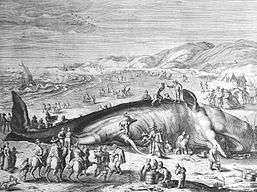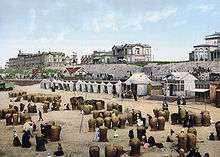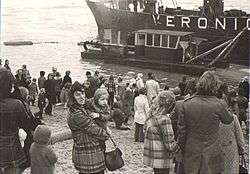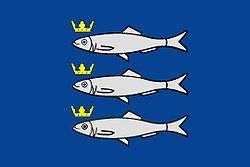Scheveningen

Scheveningen, [ˈsxeːvənɪŋə(n)] is one of the eight districts of The Hague, as well as a subdistrict (wijk) of that city. Scheveningen is a modern seaside resort with a long, sandy beach, an esplanade, a pier, and a lighthouse. The beach is popular for water sports such as windsurfing and kiteboarding.[1]
The harbour is used for both fishing and tourism.
There are local politicians who are trying to re-brand Scheveningen to The Hague Beach,[2] on account of the name being difficult to pronounce, but this has created a lot of problems with the local population that is very proud of the name Scheveningen. Initiatives have been launched to teach people all over the world how to pronounce the name properly and make videos of saying the name out loud.
It has its own dialect (Schevenings), which is different from The Hague dialect.
Subdistricts
The subdistricts of district Scheveningen are:
- Scheveningen
- Duinoord
- Statenkwartier
- Belgisch Park
- Oostduinen
- Maduroplein
- Duindorp
- Archipelbuurt
- Van Stolkpark
- Westbroekpark
History

.jpg)

The earliest reference to the name Sceveninghe goes back to around 1280.
The first inhabitants may have been Anglo-Saxons. Other historians favour a Scandinavian origin. Fishing was the main source of food and income.
The Battle of Scheveningen was fought between English and Dutch fleets off the coast of the village on 10 August 1653. Thousands of people gathered on the shore to watch.
A road to neighbouring The Hague was constructed in 1663 (current name: Scheveningseweg).
In 1470, a heavy storm destroyed the church and half the houses. The village was again hit by storms in 1570, 1775, 1825, 1860, 1881, and 1894. After this last storm, the villagers decided to build a harbour. Until then, the fishing boats had had a flat bottom (bomschuiten), and were pulled up the beach. By around 1870, over 150 of these boats were in use. Once the harbour had been constructed in 1904, more modern ships replaced the bomschuiten.
In 1818, Jacob Pronk constructed a wooden building on a dune near the sea, from where people could bathe from four separate rooms. It marked the start of Scheveningen as a bathing resort. Since then, Scheveningen has attracted numerous tourists from all over Europe, notably from Germany.

The hotel and restaurant Kurhaus was opened in 1886.
The picturesque village attracted many Dutch artists over the centuries who painted the bomschuiten drawn up on the beach, or fishermen at work in the North Sea. Notable painters who recorded the village include Adriaen van de Velde, Simon de Vlieger, and Hendrik Willem Mesdag, whose enormous panorama, 14 m high and 120 m wide, preserves the view of Scheveningen in 1881.
The International Skating Union was founded in Scheveningen in 1892.
Anecdotal evidence exists of the name Scheveningen being used as a shibboleth during World War II to identify German spies: they would pronounce the initial "Sch" differently from Dutch native speakers.[3]
Contrary to popular belief, Scheveningen was never an independent municipality, but it has its own coat of arms, officially recognised by The Hague local council (proposal 136 of 23 March 1984); even in the Middle Ages, it was part of the same administrative region as The Hague;[4] the region had a special status within the county of Holland because of the presence of the Count of Holland.
Nevertheless, Scheveningen always had a strong identity of its own. For instance, it had its own football club, playing in the highest Dutch division (its name was "Scheveningen Holland Sport"). In the course of the second half of the former century, this club was forced to merge with ADO Den Haag.

From 21 April 1960,[5] the pirate radio station Radio Veronica [6] broadcast its programmes from an anchorage in the North Sea about four miles off the Scheveningen coast, originally calling itself Vrije Radio Omroep Nederland (VRON); Free Radio Station [of the] Netherlands. It was joined by Radio Noordzee Internationaal in 1970 [7] and the relaunched Radio Caroline in late 1972.[8] When the Netherlands ratified the Treaty of Strasbourg on 1 September 1974,[9] Veronica applied for legal status and became the VOO, Caroline moved anchorage to the English coast, and RNI closed down completely.[10] Memorable episodes during this period included the stranding of Radio Veronica's ship, the Norderney, which lost its anchor in a storm and ran aground on Scheveningen beach on 2 April 1973, and a firebomb attack on RNI's ship, the Mebo II, on 15 May 1971.
Events and attractions
Annual events include:
- Winter swim on New Year's Day, locally known as Nieuwjaarsduik (New Year's dive)
- Flags Day in spring when the first new herring of the year is auctioned
- Fireworks in summer: once a week and several days during a festival week
A visit to Scheveningen can include:
- The Muzee Museum (official museum of Scheveningen)
- The pier
- The miniature city Madurodam
- The sculptures at sea museum Beelden aan Zee
- The Panorama Mesdag
- The four different beaches of Scheveningen[11]
- Our Lady of Lourdes (RC) Silent Center, in a designated national landmark complex, housing a replica of the Lourdes Grotto in Massabielle (France). The chapel, located at Berkenbosch Blokstraat 9a, is open daily from 9am to 6pm.
Night life centres on Pathé Scheveningen movie theatre, and the sea-front boulevard with its bars, restaurants, gambling halls, and other entertainment.
Anglican Church
- Church of St.John and St.Phillip The Hague part of the Diocese of Europe in the Anglican Communion.
Musea
- Atlantikwall Museum Scheveningen
- Bunker Museum Den Haag
- Beelden aan Zee
- Muzee Scheveningen
- Museumschip Hr. Ms. Mercuur, former Aggressive-class minesweeper
Lighthouse

The light beam flashes at alternate intervals of 2.5 and 7.5 seconds. The location is 52°6.247′N 4°16.095′E / 52.104117°N 4.268250°E .
Noted natives
- Machiel de Graaf (b. 1969), politician
- Romy Haag (b. 1951), dancer, singer and actress
- Cornelis Jol (1597-1641), admiral and privateer
- Dick Jol (b. 1956), football referee
- Martin Jol (b. 1956), football manager and player
- Wim Kan (1911–1983), cabaret artist
- Bert Pronk (1950–2005), cyclist
- Jan Pronk (b. 1940), politician and diplomat
- Tim Smit (b.1954), businessman, composer, environmentalist and archaeologist
- Piet Spaans (b.1933),a poet who speaks Schevenings dialect
References
- ↑ The Hague Tourist Board page on Scheveningen
- ↑ http://www.ad.nl/ad/nl/1040/Den-Haag/article/detail/4180091/2015/11/07/Scheveningen-wordt-The-Hague-Beach.dhtml?originatingNavigationItemId=5585
- ↑ McNamara, Tim (2005). "21st century shibboleth: language tests, identity and intergroup conflict". Language Policy. Springer Netherlands. 2005 (4): 351–370. doi:10.1007/s10993-005-2886-0.
- ↑ Vaderlandsch woordenboek, 1787
- ↑ Jan Akkerman interviewed in Dutch magazine Veronica, 1973
- ↑ Juul Geleick - Geschiedenis Veronica 1973
- ↑ Hans Knot - De vermeende spionage van RNI
- ↑ Radio Caroline - 1972-1980
- ↑ Billboard May 5, 1973
- ↑ radiovisie.eu - Last of the pirates
- ↑ beaches of Scheveningen
External links
| Wikimedia Commons has media related to Scheveningen. |
| Wikivoyage has a travel guide for Scheveningen. |
- Tourist Information Scheveningen
- Two Beach Streaming Livecams
- Boulevard webcam
- Boulevard weather station
